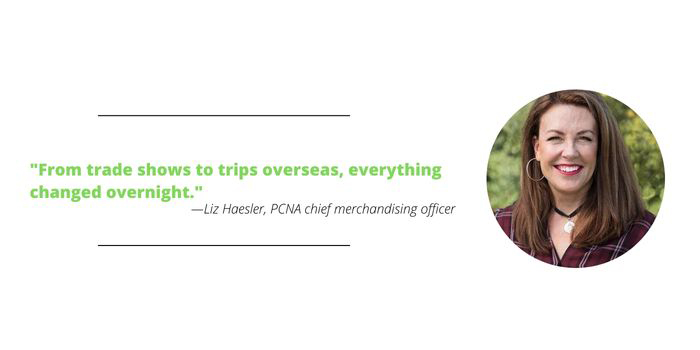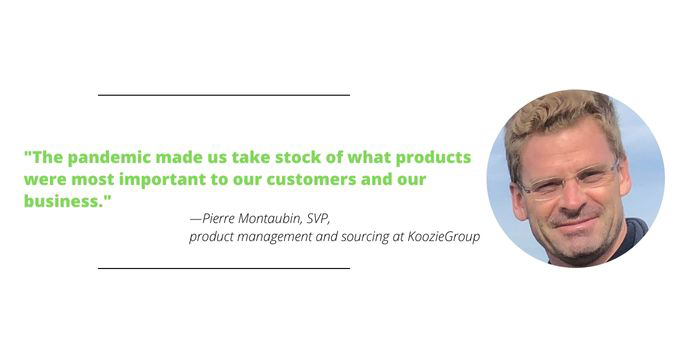The Pandemic’s Lasting Impact On Product Development

The promotional products industry is often an in-person business, where the ability to see, touch and feel goods can make all the difference. The pandemic put that practice on hiatus, and like businesses and professionals everywhere, the industry had to adapt to new ways of doing things and adopt fresh approaches to existing challenges.
For promo suppliers, the pandemic meant new and lasting ways to stay up to date on the latest products, keep in touch with clients’ needs and analyze where the market was going.
Making, Maintaining Connections
Promo industry suppliers draw product ideas from an array of sources and challenges posed by the pandemic cut off or hampered access to many of them. Many of the usual avenues – trade shows, vendor meetings, etc. – were unavailable.
“The ideas are still there for the most part,” says Pierre Montaubin, senior vice president of product management and sourcing at Koozie Group. “We had to find creative ways to connect with our vendors, especially in China, through platforms like WeChat, and we relied more than ever on our team in Asia. Having boots on the ground helped us tremendously to overcome any obstacles.”
The shift came quickly. Liz Haesler, PCNA chief merchandising officer, says, “From trade shows to trips overseas, everything changed overnight. The one element that changed in a positive way was our connection with our overseas offices in both China and with our sister company in Europe as well as our brand partners.
“Video meetings became weekly or daily occurrences that ranged from new product ideas, to supply chain factors. Regular communication with our brand partners helped us stay close to trends, as they have deep investments in product development. We were able to collaborate on new ideas and materials through the pandemic, as well as connect our brand partners with our sales team.”
The pandemic also affected the range of products available on the market. Montaubin says, “Suppliers have been cutting down on the number of products they are presenting. One example is UL-listed power banks. Because of the price of the certification and the limited market attractiveness at this time, most of our [manufacturers] have stopped developing any new ideas for these products.”
With so many traditional sources shuttered or in flux, companies had to be flexible during the pandemic. Both in how they generated new product ideas, but also in how they responded to clients’ needs. “We decided early on that it was our duty to enter into this challenge with our customers,” Montaubin says. “We had the supply chain in Asia in place, so we started importing disposable face masks and hand sanitizers. We then turned to reusable ones in the backend of 2020, which is more in our wheelhouse than non-printed face masks.”
Additionally, Koozie Group responded to the market’s need for products that combatted bacteria growth, and launched its PrevaGuard line across writing instruments and bags. It also introduced several no-contact tools like keychains and styluses.

With so much of the “normal” way of doing things up-ended, companies not only sought new ways of doing business but fresh perspectives.
“We formed a partnership with WGSN – one of the top global trend networks – which helped us stay on top of innovation in style, trend and materials,” Haesler says. “We attended virtual trade shows, and followed retail and social media to scout for trends, as well as regular communication with our retail brand partners. We also implemented our ‘Plugged In’ series, providing us with a new way to connect with our customers.”
Lasting Changes
The lessons of the pandemic linger in many suppliers’ thinking. Their approach to what products they offer and how they develop them have been shaped by the COVID years.
“The pandemic made us take stock of what products were most important to our customers and our business,” says Montaubin. “We did eventually pare down our assortment to focus on what we do best. We put our attention on what our customers know us for and the brands they love. We also expanded the number of products with our ‘Keep It. Give It.’ designation to almost half of our offerings, and we’ll continue adding to this list in the future.
Haesler noted that the pandemic led to shifts in what clients were buying. She says, “Our strategy, pre-pandemic, was introducing incremental brands to our assortment, with a continued focus on offering good, better and best assortments. The pandemic brought a higher average unit sale, as end users were looking for consumer and employee gifts. Branded business was positively impacted by these consumer trends.”
Looking forward, as the industry exits the worst of the pandemic’s business effects, industry companies are assessing the lessons it taught and effects it had on their product development practices. At Koozie Group, it lent support to initiatives the company was already pursuing, such as its KG Factor – products with a high likelihood of being kept or gifted as determined by an impartial survey of end consumers, making it easier for customers to select items designed to lessen environmental impact through longevity.
“The pandemic reinforced what we already knew and what our customers were starting to tell us prior to the pandemic: They want purposeful products, made of sustainable resources when possible, that customers and employees can reuse and want to keep,” Montaubin says. “We already had our KG Factor designation, and we’re putting it front and center when developing new items.
“We’re always on the lookout for products made from more sustainable materials, like recycled PET. And in 2021, all three of our sites became Forest Stewardship Council and Sustainable Forestry Initiative certified. Nearly every one of our calendars and Souvenir Sticky Note adhesive and scratch pads are now made of sustainably made paper.”

At PCNA, Haesler noted that the pandemic honed ways of doing business that will likely continue to pay dividends, and reinforced certain existing market initiatives.
“As so much of our development was remote – with samples moving back and forth overseas, to our offices, and for deco testing – collaboration and communication became mission critical, and relationships between capabilities greatly improved,” she says. “We will continue that as we move forward, as well as the strong communication we have with our overseas sourcing team and factories.
“Lastly, the deeper penetration we have seen around brands will continue, especially as it relates to Proud Path – environmentally and socially responsible brands and promotional products. We have worked together on strategies like bluesign [an organization supporting manufacturers in sustainable, resource-saving production of clothing and textiles] or shifting from where we source our products.”
The Impact Of PPE
Personal protective equipment was a lifeline for many businesses in the promotional products market. It is a product category that was in high-demand and relatively easy for the industry to pivot toward, considering its manufacturing capabilities and product-sourcing connections. Six months into the pandemic, more than half (57%) of distributors and almost a quarter of suppliers (24%) told PPAI that it accounted for 30% or more of their orders.
“PPE certainly kept the doors open when our order count went down drastically starting in March 2020,” says Montaubin.
Haesler adds that PPE played a significant role at PCNA as well. She says, “Our PPE focus was on an existing hand sanitizer assortment, and we introduced disposable and cloth masks at the beginning of the pandemic.”
As the market shifts away from pandemic-driven priorities, PPE is not expected to play as significant a role but will remain, to some degree, in suppliers’ catalogs.
“Hand sanitizer and face masks are not and never were a large percent of our total business,” says Haesler. “We continue to sell hand sanitizer and are moving into a more robust health and wellness business.
Montaubin says, “We have scaled back our offerings but still have a steady stream of orders, particularly on our reusable face masks and exclusively designed hand sanitizers. We intend to keep those products for the foreseeable future but will discontinue the majority of our PPE items.”

